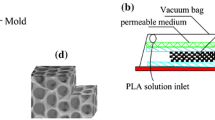Abstract
Scaffold morphology plays a key role in the development of tissue engineering constructs. The control of pore size, shape and interconnection is needed to achieve adequate nutrient transport and cell ingrowth. Several techniques are available for scaffold manufacturing, but none allows easy control of morphology and is, at the same time, applicable to a wide variety of materials.
To investigate the possibility of processing a wide range polymers by solvent casting/particulate leaching with accurate control of scaffold morphology, three different porogens (gelatin microspheres, paraffin microspheres and sodium chloride crystals) were used to fabricate scaffolds from commonly employed biodegradable polymers. The outcome of processing was evaluated in terms of scaffold morphology and structure/properties relationships.
Highly porous scaffolds were obtained with all porogens and well defined spherical pores resulted from microspheres leaching. Furthermore, scaffolds with spherical pores showed better mechanical performance and lower flow resistance. Cytocompatibility tests performed showed no evidence of processing residuals released from the scaffolds.
Solvent casting/microspheres leaching, particularly gelatin microspheres leaching, can be used to process a large number of polymers and enables to tailor scaffold pore size, shape and interconnection, thus providing a powerful tool for material selection and optimization of scaffold morphology.
Similar content being viewed by others
References
S. YANG, K. F. LEONG, Z. DU and C. K. CHUA, Tissue Eng. 7 (2001) 679.
A. MIKOS, A. THORSEN, L. CZERWANKA, Y. BAO, D. WINSLOW, J. VACANTI and R. LANGER, Polymer 35 (1994) 1068.
T. FREYMAN, I. YANNAS and L. GIBSON, Progress in Materials Science 46 (2001) 273.
A.G. MIKOS, Y. BAO, L.G. CIMA, D.E. INGBER, J. VACANTI and R. LANGER, J. Biomed. Res. 27 (1993) 183.
S. YANG, K.F. LEONG, Z. DU and C.K. CHUA, Tissue Eng. 8 (2002) 1.
C. LHOMMEAU, H. LEVENE, S. ABRAMSON and J. KHON, ibid. 4 (1998) 468.
P. MA and J.W. CHOI, ibid. 7 (2001) 23.
W. L. MURPHY, R. G. DENNIS, J. L. KILENY and D. J. MOONEY, ibid. 8 (2002) 43–52.
E. ESPOSITO, R. CORTESI and C. NASTRUZZI, Biomaterials 17(1996) 2009.
EN IS0 1923 : 1995, “Cellular plastics and rubbers—Determination of linear dimensions”.
A. BRUGOLA, “Espansi poliuretanici come matrici di compositi biomimetici per la ricrescita del tessuto osseo” Master thesis, Politecnico di Milano, 1999.
EN ISO 4590:2003, “Rigid cellular plastics—Determination of the volume percentage of open cells and of closed cells”.
Author information
Authors and Affiliations
Rights and permissions
About this article
Cite this article
Draghi, L., Resta, S., Pirozzolo, M.G. et al. Microspheres leaching for scaffold porosity control. J Mater Sci: Mater Med 16, 1093–1097 (2005). https://doi.org/10.1007/s10856-005-4711-x
Received:
Accepted:
Issue Date:
DOI: https://doi.org/10.1007/s10856-005-4711-x




